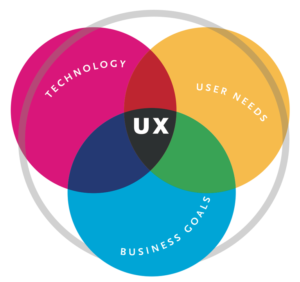What is Design
When we think about design, we generally think about colors, shapes, images, and words, all placed tastefully on a web site or poster or business card. Design does include these things. But design includes much much more. For very good reasons, one of the hot buzzwords these days is “UX” – which stands for “User Experience” design. When you press this button, what exactly will it do? When you choose an item from this list, what will happen? These are the issues that User Experience Design revolves around.
However, there are more dimensions of design than this. Server infrastructure is a design issue: which machines sitting where on the network will house which kinds of data and systems? Backup and recovery protocols are a design issue. Redundancy is a design issue: which parts of the system need to be duplicated so that if the primary fails, a secondary can automatically come in to save the day? Database table structure is a very important design issue. Cyber-security is a design issue. All of these design issues can only be decided in response to clearly defined User Experience which implements the business requirements. For better or for worse, these things will all end up being designed somehow, and they are designed best when they are envisioned in light of clear project definitions and User Experience.
Good Design is Simple
The hallmark of great User Experience design is that it is simple. It is self-explanatory and very easy to figure out. You don’t get this kind of simplicity unless it is spare. Good design hides features, and puts the most used feature right at your fingertips. Good UX design helps you make decisions and do the most work with minimal effort, and takes care of the tedious parts of the work for you.
Good Design = More Usefulness for Less Time and Money
Good up front User Experience design has far more benefits than just being easy to use, however. When the system and its usability have been designed well, it saves on wasted development time. It also reduces total development time, since there is a clear goal and unwanted features don’t have to be removed from the code base. The cost of time and adding bugs to the code base increases the closer one gets to a launch, and good up front UX minimizes this problem. Also, when the design is simply drawings on paper or partially working mockups, users can have a look and respond before so much has been invested in the build. 70% of projects that fail fail because of a lack of user acceptance. Good practice UX can avoid this problem!
UX can also give a good bit of thought to the kind of usage the system will get. If there are expected to be a lot mobile users, the site or system can be optimized and guarantee more return on the investment.
Good UX also lowers the costs of support, since it is designed to be understandable in the first place and has been tested for usability before launch. It also increases user retention. There is simply no end to the number of benefits when you carefully define the system requirements and then design a user-centered system around those requirements. The business wins, the users win, and the developers and IT workers win. It’s the best way to do business!
For way more information on the benefits of User Experience design, read this amazing post!

